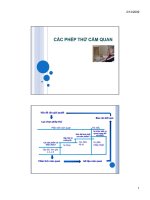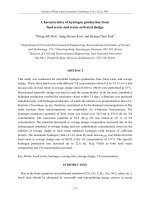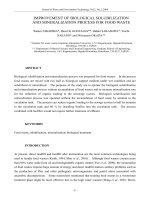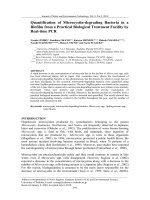practical food fermentation bt404c
Bạn đang xem bản rút gọn của tài liệu. Xem và tải ngay bản đầy đủ của tài liệu tại đây (2.82 MB, 36 trang )
MINISTRY OF EDUCATION AND TRAINING
CAN THO UNIVERSITY
BIOTECHNOLOGY RESEARCH AND DEVELOPMENT INSTITUTE
PRACTICAL REPORT
FOOD FERMENTATION
(CODE: BT404C)
Group 3
Instructor:
Students:
Trần Vũ Phương
Đinh Châu Hải Đăng
Trần Thị Thảo My
Đặng Thị Thanh Trúc
Trần Thị Bảo Châu
Lưu Minh Long
Phạm Thảo Nguyên
Ngô Thanh Nhã
Trần Yến Nhi
Đặng Minh Tâm
Trần Nguyễn Nguyệt Thanh
CẦN THƠ, 04/2022
0
B1904225
B1904532
B1904650
B1904672
B1904681
B1904688
B1904689
B1904693
B1904695
B1904697
THƠNG TIN SINH VIÊN
TT
1.
Thơng tin sinh viên
Hình sinh viên
Họ tên: Đinh Châu Hải Đăng
MSSV: B1904225
Mã Lớp: DA1966T1
Số ĐT: 0847067405
2.
Họ tên: Trần Thị Thảo My
MSSV: B1904532
Mã Lớp: DA1966T1
Số ĐT: 0842585002
3.
Họ tên: Đặng Thị Thanh Trúc
MSSV: B1904650
Mã Lớp: DA1966T1
Số ĐT: 0394268001
4.
Họ tên: Trần Thị Bảo Châu
MSSV: B1904672
Mã Lớp: DA1966T1
Số ĐT: 042786192
1
TT
5.
Thơng tin sinh viên
Hình sinh viên
Họ tên: Lưu Minh Long
MSSV: B1904681
Mã Lớp: DA1966T1
Số ĐT: 0818444255
6.
Họ tên: Phạm Thảo Nguyên
MSSV: B1904688
Mã Lớp: DA1966T1
Số ĐT: 0868735353
7.
Họ tên: Ngô Thanh Nhã
MSSV: B1904689
Mã Lớp: DA1966T1
Số ĐT: 0775871388
8.
Họ tên: Trần Yến Nhi
MSSV: B1904693
Mã Lớp: DA1966T1
Số ĐT: 0987918533
2
TT
9.
Thơng tin sinh viên
Hình sinh viên
Họ tên: Đặng Minh Tâm
MSSV: B1904695
Mã Lớp: DA1966T1
Số ĐT: 0925109189
10. Họ tên: Trần Nguyễn Nguyệt Thanh
MSSV: B1904697
Mã Lớp: DA1966T1
Số ĐT: 0943284471
3
Contents
Lesson 1 ........................................................................................................................................... 6
THE ALCOHOLIC FERMENTATION OF RICE WINE ........................................................ 6
I. INTRODUCTION ...................................................................................................................... 6
1. Product ................................................................................................................................. 6
2. Microorganisms ................................................................................................................... 6
3. Ingredient(s) ......................................................................................................................... 7
II. MATERIALS............................................................................................................................. 7
III. PROCEDURE .......................................................................................................................... 9
IV. RESULTS AND DISCUSSION ............................................................................................ 11
1.
pH change through per stage ........................................................................................ 14
2.
Brix level change through per stage ............................................................................ 15
3.
Growth of mold ............................................................................................................. 15
4.
The growth of yeast fungal ........................................................................................... 16
5.
Alcohol concentration after fermentation ................................................................... 16
V. CONCLUSION ........................................................................................................................ 17
Lesson 2 ......................................................................................................................................... 18
TEMPE FERMENTATION........................................................................................................ 18
I.
INTRODUCTION ....................................................................................................... 18
1.
Product .......................................................................................................................... 18
2.
Microorganisms ............................................................................................................ 18
3.
Ingredient(s) .................................................................................................................. 19
II.
MATERIALS ............................................................................................................... 19
III.
PROCEDURE .............................................................................................................. 20
1.
A protocol for tempeh fermentation ............................................................................. 20
2.
Explain the process ....................................................................................................... 21
IV.
RESULTS AND DISCUSSION .................................................................................. 22
1.
The change of pH through the stages ............................................................................ 23
2.
Identifying dry matter ................................................................................................... 23
3.
Results of chemical analysis (Formol nitrogen) ............................................................ 25
4.
Quality Evaluation Criteria ........................................................................................... 25
V.
CONCLUSION ............................................................................................................ 26
LESSON 3...................................................................................................................................... 27
PICKLES FERMENTATION .................................................................................................... 27
I.
INTRODUCTION ....................................................................................................... 27
1.
Product .......................................................................................................................... 27
2.
Microorganisms ............................................................................................................ 27
4
3.
Ingredient(s) .................................................................................................................. 29
II.
MATERIALS ............................................................................................................... 29
III.
PROCEDURE .............................................................................................................. 30
1.
A protocol for pickles fermentation.............................................................................. 30
2.
Explain the process ....................................................................................................... 31
IV.
V.
RESULTS AND DISCUSSION .................................................................................. 31
1.
The change of pH during fermented time ...................................................................... 34
2.
Results of acid analysis .................................................................................................. 35
3.
Quality Evaluation Criteria ........................................................................................... 35
CONCLUSION ............................................................................................................ 35
5
Lesson 1
THE ALCOHOLIC FERMENTATION OF RICE WINE
I. INTRODUCTION
1. Product
Like other traditional fermented alcoholic beverages in other East-Asian countries, rice
wines are popular in Vietnam. The production of rice wine is a source of income for farmer
families in rural areas. In Vietnamese, Ruou means wine. In the north and south, we can
find Ruou De or Ruou Nep: these are fermented from rice or glutinous rice, respectively,
followed by distillation. In mountainous districts, such as Da Lat, Buon Me Thuot, and Dac
Lac, an ethnic minority (Thuong people) produce Ruou Can which is fermented from rice,
maize or cassava, with or without distillation.
In particular in the Mekong Delta of the south, Ruou Nep Than (purple glutinous rice
wine) is made from purple glutinous rice without further distillation. It is commercialized in
two qualities: crude cloudy wine containing sediment, and clear filtered wine. Its
manufacture follows a traditional fermentation process in which powdered starch-based
starter is mixed with steamed gelatinized purple glutinous rice, which is then incubated
under ambient conditions.
2. Microorganisms
Rice
wine
fermentation
also
depends
on
mold
and
yeast.
In
particular, Rhizopus, Saccharomyces, and Saccharomycosis are popular genera in starters
and are considered to be important functional microorganisms.
The major molds are Amylomyces rouxii, Rhizopus spp. and Mucor spp., and the
commonly present yeasts are Saccharomyces cerevisiae, Hansenula spp., Endomycopsis
flbuligera and Candida spp. The molds produce α-amylase and amyloglucosidase (also
called glucoamylase) that hydrolyze starch to dextrins and maltose but mainly to glucose.
Yeasts are significant in winemaking because they conduct the alcoholic fermentation
but some may also spoil wines during storage through changes of biochemical activities (eg.
metabolism of carbohydrates, nitrogen compounds, organic acids, or degradation of lipids,
production of polyols) or have negative affects on wine quality through autolysis.
6
3. Ingredient(s)
Depending on available ingredients and preferences in the region, different kinds of
agricultural starchy materials may be utilized. The most popular materials are dehulled rice
including whole or broken rice (Oryza sativa L.), glutinous rice and purple glutinous rice.
Rice is the seed of the grass species Oryza sativa (Asian rice). The name wild rice is
usually used for species of the genera Zizania and Porteresia, both wild and domesticated,
although the term may also be used for primitive or uncultivated varieties of Oryza.
As a cereal grain, domesticated rice is the most widely consumed staple food for over
half of the world's human population,
agricultural
commodity
with
especially in Asia and Africa. It is the
the
third-highest
worldwide
production,
after sugarcane and maize. Since sizable portions of sugarcane and maize crops are used for
purposes other than human consumption, rice is the most important food crop with regard
to
human
nutrition
and
caloric
intake,
providing
more
than
one-fifth
of
the calories consumed worldwide by humans. There are many varieties of rice and culinary
preferences tend to vary regionally.
II. MATERIALS
No.
Name
1.
Red-brown rice
(Gạo lức Huyết Rồng)
2.
Yeast and Mold
Picture
Saccharomyces cerevisiae
7
Amylomyces rouxii
3.
Distillation Equipment
4.
Erlenmeyer flask 250
mL
5.
Plastic graduated
cylinder
6.
Waterlock, pH meter,
Thermometer, Alcohol
meter
7.
Brix refractometer
8
III. PROCEDURE
A protocol for wine fermentation:
Put in 5 erlenmeyer flasks (250 mL) 50 gr red-brown rice / flask
↓
Soak in 60 mL of water for 4 hours at room temperature
Figure 1.1. The red-brown rice is soaked in 60 ml of water.
Steam 4 flasks in autoclave for 1 hour at 1000C
1 flask used to measure pH
↓
Cool to 35-400C
↓
Inoculate with 2 gr of starter and mix well
Figure 1.2. 2 gr starter is measured by analytical balance 2 digits.
9
Figure 1.3. 4 flasks are inoculated with 2 gr starter and mix well.
↓
Solid-state incubation at 300C for 2 days for fungal growth
(Observation of mycelium growth and exudation)
Add 70 mL of sterile water into 3 flasks
1 flask used to measure pH and Brix
Figure 1.4. 3 flasks are added to 70 ml of sterile water.
↓
Submerged incubation at 300C for 4 days for yeast fermentation (with Waterlock)
[Observe daily for the alcoholic fermentation by gas production (counting bubbles/2
minutes)]
↓
Harvest and distill to measure ethanol content
Figure 1.5. 250 mL of alcohol after fermentation is distilled by distillation system.
↓
Assess subjectively for taste, fragrance, color of clear wine
10
IV. RESULTS AND DISCUSSION
Figure 1.6. The pH (5.72) of soak water is measured by pH meter.
Figure 1.7. Sugar exudation and mycelium growth after days 1, 2, and 3.
11
Figure 1.8. The Brix (22⁰) and pH (4.90) results before the sterile water is added.
Figure 1.9. The Brix (5⁰) and pH (4.80) results after the sterile water is added.
Figure 1.10. The number of bubbles produced in 2 minutes after 24, 48 and 72 hours.
12
Figure 1.11. The Brix and pH results of wine production is measured by Brix
refractometer and pH meter.
Figure 1.12. The Alcohol concentration (40⁰) and temperature (35℃) of the distilled
wine are measured by alcohol meter and thermometer.
Figure 1.13. The distilled wine is removed impurities.
13
1. pH change through per stage
Group
1
2
3
Material
Glutinous rice
White rice
Red-brown rice
pH before
add sterile
water
4.48
4.47
4.90
pH of soak
water
4.45
4.70
5.72
pH after add
sterile water
pH of wine
4.38
4.36
4.80
4.46
4.30
4.78
GRAPH OF pH CHANGE THROUGH PER STAGE
7
Glutinous rice
6
Rice
Red-brown rice
pH after add
sterile water
pH of wine
5
4
3
2
1
0
pH of
soak water
pH before add
sterile water
The pH of 2 samples of white rice and red-brown rice from the starting stage to the
finished product decreased. Only glutinous rice has a fluctuation in pH which may be due to
influence from the external environment or an error in the pH measurement process. In
addition, in group 1, the pH after add water was lower than the pH of the wine, possibly
because during the water soaking process, the group suddenly added water to the Erlenmeyer
flask, causing the water to be incompletely dissolved with the amount of acid present in the
leachate. Then, when the group measures the pH at this time, the pH will be very low because
the amount of acid that exists is still high. The pH will become more accurate and stable
when the acid is completely dissolved with water.
Initial pH (pH of soak water) of white rice and red-brow rice more increase than pH
in fermentation because the process of mold growth reduces the pH of the raw material.
After fermentation, the yeast uses sugar in the raw material to convert it into alcohol,
producing some organic acids, and the activity of lactic acid bacteria leads to a decrease in
the pH of the medium.
14
The pH of the red-brown rice samples at all stages (except the soaking stage) was
higher than that of the remaining samples. Because in the early stages, the red - brown rice
has the husk and the bran layer do not absorb as much water as other rice, after steaming,
the temperature has broken the structure of the grain shell, so the ability to absorb water is
higher.
2. Brix level change through per stage
Group
Material
1
2
3
Glutinous rice
White rice
Red-brown rice
Brix level
before soak of
water
32
20
22
Brix level after
soak of water
Brix level of wine
14
5
5
8
7
7
In all 3 groups, the Brix level after 3 days of incubation was very high because at
this stage, the mold was still carrying out the saccharification process, and the sugar
synthesized by the mold had not been lost.
In group 1, the Brix through the stages was decrease clearly due to the activity of
yeast using sugar during alcoholic fermentation.
In groups 2 and 3, the Brix of the wine is higher than the Brix after soaking with
water, which goes against the theory. This mistake is possible in the implementation process.
3. Growth of mold
The growth of mycelial fungi
Group
Material
Day 1 Day 2 Day 3
1
2
The liquefaction
Glutinous
rice
Day 1
Day 2
Day 3
Day 4
+
+
++
++
+
+
++
++
+
+
+
+
+
+
++
++
+
+
++
++
+
+
++
++
White
rice
Day 4
Red 3
brown
rice
Note: “+” represents the mycelia fungi density and The liquefaction content that appeared
over the days of incubation.
15
After 1 day of incubation, all 3 groups detected mycelia fungi and liquefaction.
However, the growth of fungi in group 2 over the days did not show any signs of an increase
due to liquefaction making it difficult to observe the mycelial fungi.
For liquefaction after 3 days of incubation: group 1 had a lot of liquefaction after
incubation, groups 2 and 3 were quite similar, and liquefaction appeared on day 1.
4. The growth of yeast fungal
Group
1
2
3
Material
Glutinous
rice
White rice
Red-brown
rice
Bubbles / 2 min
24 hour
48 hour
72 hour
94 hour
28
10
9
0
50
27
6
0
42
24
6
0
25
21
9
2
13
13
4
0
2
1
0
0
22
12
9
0
27
12
10
0
29
10
9
0
On the first day of fermentation, the air bubbles of all 3 groups were relatively
abundant due to yeast growth and the fermentation process was relatively strong.
In general, air bubbles generated during 3 days of incubation in all 3 groups
decreased gradually. On day 2, the fermentation in flask 3 of group 2 almost ended (only 1
air bubble / 2 minutes), and the number of air bubbles in groups 1 and 3 were still quite
large, so the fermentation process was still going strong.
On day 4, the fermentation process ended, the number of air bubbles on this day
haven't in all 3 groups.
5. Alcohol concentration after fermentation
Group
Material
1
Glutinous rice
2
White rice
3
Red-brown rice
Alcohol concentration
16.38°
16°
16°
16
Temperature
32°C
35°C
35°C
Group 1 has the highest alcohol content.Because the fermentation process produces a
lot of liquefaction along with the active yeast fermentation thanks to the appropriate raw
materials, the alcohol content of the finished wine is quite high.
V. CONCLUSION
Wine quality is greatly influenced by yeasts, molds, materials and production
processes.
Through the survey and comparison of fermented alcohol products from three
different ingredients, it can be seen that the alcohol fermentation in glutinous rice and rice
is better than that of red-brown rice, possibly due to the characteristics of each type of
material and operations of each group.
17
Lesson 2
TEMPE FERMENTATION
I.
INTRODUCTION
1. Product
Tempeh or tempe is a traditional Indonesian food made from fermented soybeans. It is
made by a natural culturing and controlled fermentation process that binds soybeans into a
cake form.
Tempe is sold in a traditional market in Indonesia. It is especially popular on the island
of Java, where it is a staple source of protein. Like tofu, tempeh is made from soybeans, but
it is a whole soybean product with different nutritional characteristics and textural qualities.
Tempeh's fermentation process and its retention of the whole bean give it a higher content
of protein, dietary fiber, and vitamins. It has a firm texture and an earthy flavor, which
becomes more pronounced as it ages.
Tempeh begins with whole soybeans, which are softened by soaking, and dehulled,
then partly cooked. Specialty tempeh may be made from other types of beans, wheat, or may
include a mixture of beans and whole grains.
Tempeh is 60% water, 20% protein, 8% carbohydrates, and 11% fats. In a reference
amount of 100 grams, tempeh supplies 192 calories, and is a rich source (20% or more of
the Daily Value, DV) of several B vitamins and dietary minerals, such as riboflavin (30%
DV) and manganese (62% DV), respectively.
The soy carbohydrates in tempeh become more digestible as a result of the fermentation
process. In particular, the oligosaccharides associated with gas and indigestion are greatly
reduced by the Rhizopus culture. In traditional tempeh-making shops, the starter culture
often contains beneficial bacteria that produce vitamins such as B12. The fermentation
process also reduces the phytic acid in soy, which in turn allows the body to absorb the
minerals that soy provides.
2. Microorganisms
Rhizopus oligosporus is the main microorganism that plays important role in tempe
fermentation process. Besides fungi, other microorganisms may also participate in tempe
fermentation process as the fermentation is not carried out under aseptic conditions although
starter culture is added.
18
During soaking lactic acid bacteria (LAB) and yeasts have been detected. LAB that
present in high numbers during soaking, acidify the bean under natural fermentation.
Soaking helps controlling microbial populations in tempe.
LAB are considered to have a role in controlling pathogenic bacteria during tempe
production. LAB were reported to suppress the growth of pathogenic bacteria in soybean.
Study on soybean that was deliberately inoculated with pathogenic bacteria suggests that the
presence of Lactobacillus plantarum could inhibit the growth of Listeria monocytogenes
and inhibits staphylococcal toxin production. Tempe also contains undesirable
microorganisms that can reduce its quality. Bacillus grows during tempe fermentation and
is considered to cause a bitter taste. The presence of lactic acid bacteria in tempe has a
potential to improve quality and safety of tempe.
3. Ingredient(s)
Soya bean or soybean (Glycine max (L). Merr.) is a legume native to Eastern Asia
belonging to the Fabaceae family. It is widely consumed in East Asia and Southeast Asia
countries as fermented and non-fermented products (Rizzo and Baroni, 2018). The people
in this region believe that the daily intake of fermented soy food in the diet contributes to
the prevention of chronic diseases and improved well-being. Although the Asian population
is the major soybean consumer historically, the trend of soybean consumption in Western
countries is increasing, in line with the widespread vegetarian diet and the perception of a
beneficial effect of soybean intake in the daily diet (Huang et al., 2016). Fermented soybased foods have been associated with an excellent source of nutrition and health benefit
qualities due to the high protein content and rich in phytonutrients such as isoflavones.
II.
No.
MATERIALS
Name
Picture
1. Soybeans
19









